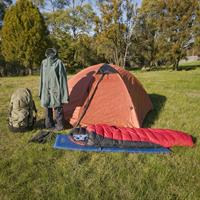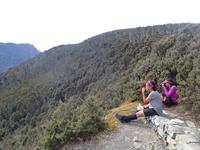Sometimes, the weather doesn't agree with our trekking plans. Other times, our plans lead us right into a not very human-friendly climate. Especially in high terrain in mountain ranges, such as the Himalayas, cold and stormy weather is to be expected. In the flat marshlands of northern Germany, rain and hail are always possible to occur during a long hike. And even in “warm and sunny” Australia, winter can get quite cold, with the record low temperature in Tasmania in June being -13 degrees Celsius.
The effects of cold weather on your hike can range from a bad view, and over attaining a nasty cold to serious conditions such as hypothermia and frostbite. This is why the right gear and behaviour are key to an enjoyable hike as well as to your own safety and survival.
Find below:
- Cold weather hiking tips including gear and clothing to wear
- Food and hydration tips
- Ways to avoid injuries and illness in cold weather conditions
Gear and clothing to bring when hiking in winter

The first of many winter trekking tips to remember is layering. Layering your clothing is the best way to stay warm and dry, without getting extremely sweaty once you get to a more challenging part of the track.
This is especially important in avoiding hypothermia, a condition that describes your body temperature drops below normal. It can be life-threatening and does not only occur in freezing climate conditions but can also be caused by trekking in the (cold) rain or spending just a little too much time in cold, moving bodies of water.
This is why it is important to consider layering, even when you are not planning on hiking through the Himalayas. The system usually consists of three layers. Each serves its own function in keeping you warm.
Start off with a base layer, which transports your sweat away from your skin. Then add a middle layer for insulation. Lastly, wearing an outer layer as a shell will shield you from wind, rain, and snow. This way, when the sun comes out, you can take off a layer or two to avoid overheating.
To learn more about layering, check out our cold weather clothing guide on layering clothing.
You have this awesome cotton shirt that you think would work perfectly for your long hike in a cold climate and you already put it in your backpack? Well, the best thing you could do is probably to take it out and replace it with a shirt made of synthetic material or (merino) wool. Cotton is known for its extraordinary ability to keep you cold when it is cold outside and to keep you hot when it is hot outside. Which is exactly what we don't want in any type of trekking situation. Once you start sweating, it will also then hold the sweat and keep you wet throughout the day.
Additionally, cotton is known for drying very slowly, which is why you might even have to slip into your still-wet cotton shirt from yesterday on an overnight hike.
Other materials such as wool have the natural ability or have been specifically designed to keep you dry, by transporting the moisture from your body to the next layer of clothing and also have a well functioning, temperature regulating properties. This makes them all better suited for hiking in cold weather than cotton.
Your skin is your largest organ and very much worthy of protection. Covering your skin is going to prevent it from frostbite caused by low temperatures and the freezing winter breeze. Frostbite basically means the tissue of the affected area has frozen. There are three stages of frostbite, which all may look the same when they are still in a frozen state, which makes it difficult to determine the severity of the condition while it is happening. It mostly occurs on fingers, toes, and ears.
Hide your hands in fleece gloves and your nose and cheeks underneath a neck gaiter as a facemask to protect them.
YOUR HANDS: Depending on the climate and your surroundings, you might want to choose waterproof gloves over plain ones to keep your fingers dry and warm.
YOUR SKIN: And while we are on the topic of protecting your skin: the sun can always have a harmful effect on your skin, even if it is cold outside and you can't really feel its warmth. Especially if you are in a snowy area and the sunrays are being reflected by the white blanket on the landscape, your skin needs sun protection to stay healthy. So keep that sunscreen in your hiking backpack throughout the colder months and don't forget to use it regularly.
YOUR FEET: Your feet are another part of your body that cools down quickly. Wearing thicker socks can keep your feet warm, but make sure you still fit into your boots when wearing them. Otherwise, they might hurt your feet more than they can help them. Watch out for the material you use here again.
Good hiking socks should basically act like a part of your base layer and transport moisture from your foot to your shoe.
If your shoes are breathable, the moisture is then going to be transported out of the shoe and your feet will stay dry.
If you have waterproof Gore-Tex shoes, on the other hand, the moisture will be trapped inside your shoe, leading to wet socks.
It helps to carry an extra pair of socks you can swap out if you feel your feet getting wet and cold.
YOUR HEAD: Now onto the most important part: your head. It hosts our brains, our ability to reason and make plans and is the part of your body through which you will lose the most of your body heat. Protect your head and your ears with a hat or a warm headband.
If you are hiking through snow-covered landscapes, consider using gaiters to keep the snow out of your boots. Besides, they form an extra layer between you and the cold, providing a little extra warmth.
Sunrays, which are being reflected by the snow, can not only give you a sunburn but also hurt your eyes. Consider bringing sunglass to avoid sun glare and also protect your eyes from cold wind and snow.
First of all, make sure to bring enough of them. Second of all, batteries don´t deal well with extreme temperatures and tend to die easily if exposed to cold weather for longer. You can store your batteries and electronics close to your body to keep them warm using your body heat. At night you can do the same by keeping them in your sleeping bag.
It is not only important to protect your body from getting wet, but also the inside of your pack if you don't want to sleep in a soaking wet sleeping bag (which you definitely don't!). To protect your pack, use a pack liner, such as a trash compactor bag, on the inside of your backpack.
Food and hydration when winter hiking
Hydration is not only important on a hot and sunny day when you are sweating out all the fluid you just consumed an hour ago. It is widely underestimated how important hydration is on a cold day.
When the temperature outside is freezing, you lose moisture through every breath. The fluid evaporates in white, misty clouds when you exhale. This adds to the loss of fluid your body is already experiencing through sweating.
Keep sipping on your water bottle frequently and avoid getting thirsty in the first place, because if you can feel the thirst, you are already dehydrated.
Keep your water bottle warm to stop your water from freezing. Store your bottle inside of your pack, instead of putting it in an outer pocket to add an extra layer of warmth around it. A foam sleeve around your water bottle will do the same trick.
Another easy hack is to boil your water before you pack down your camp and continue your hike in the morning on an overnight hike. This way, it will take longer to reach freezing temperature.
At night, there are few things more appreciated than a hot drink by the fire after a long day of strenuous trekking. If it is extremely cold, you can even refill your water bottle with hot water afterwards and put it inside your sleeping bag to act as a hot water bottle during the night.
Lastly, if you are seriously concerned about your water’s state, you can carry your water bottle inside your jacket to keep it warm with your body heat. In both cases, make sure to seal your bottle properly before you attempt to do this!
Take plenty of high-energy snacks and eat them in regular intervals throughout the day. You could take chocolate bars, banana chips, homemade trail mix or even pricey energy bars, gels, dried meals etc. Hiking in the snow can be extremely tiring and you will have to make sure to keep your body strong to make it more resistant to hypothermia and other illnesses. If you are on an overnight hike, consume a meal based on fat and protein in the evening. These are processed slower by the body and will keep you full for longer.
How to avoid injuries and illnesses when trekking in cold conditions
You are about to go on a hike in a colder area, but don't want to invest in a new, expensive winter sleeping bag? You might be able to use a sleeping bag liner to add an extra layer to your sleeping bag and a little more warmth when you are lying inside of it. It is a good idea to try this out before you go on your hike, to see if the sleeping bag liner provides enough extra warmth for you. We don't want you freezing on top of a mountain.
The sun is less strong, rises later and sets earlier in winter. Prepare for this by bringing a head torch and planning your days accordingly if you are on a self-guided hike.
Don't forget to pack an extra pair of batteries for your torch too.

Keep moving to keep yourself warm. The longer you stop, the more time your body has to cool down, so keep breaks as short as possible if you are hiking in a cold climate.
If you have to take a longer break, put on an extra layer of clothing. Otherwise, you will find yourself freezing after a short amount of time.
If you are feeling unwell, there is no reason to suck it up and keep going. Actually, this is exactly what you should not do when you are feeling ill on a hike.
Take yourself and your body seriously, listen to it and notify your guide if you are feeling unwell.
Ready to hit the winter trails? View our range of Tasmanian winter treks >